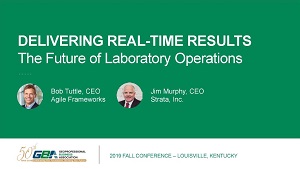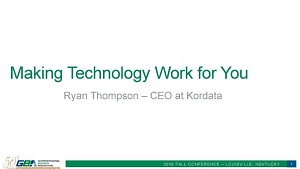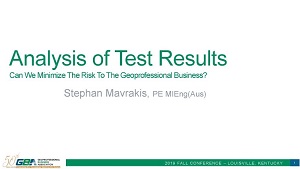2019 Fall Conference Proceedings
MEMBERS: Please login
when viewing this page! You’ll have free, easy access to all videos.
Download the handouts

FA19-01 Embracing Big Data and Disruptive Innovation
This video is only available to members; join GBA today to watch it.
The explosion of big data technologies and Internet of Things (IoT) sensors have led to dramatic advancements in data-driven optimization, artificial intelligence (AI), and machine learning. Data analytics is revolutionizing countless industries including energy production, infrastructure development, transportation systems, and commercial and residential construction. Industry by industry, region by region, and country by country, we are optimizing everything we do on this planet. Patrick Schwerdtfeger, business futurist specializing in technology trends, highlights the areas most disrupted by big data and what we can expect to see in the years ahead. He also introduces two models to anticipate and even capitalize on disruptive innovation. Geoprofessionals need to leverage big data opportunities.
This is a time for innovative thinking and bold leadership! (68 minutes)

FA19-02 Advanced Data Analytics in Geotechnical Engineering
This video is only available to members; join GBA today to watch it.
Big data, machine learning, artificial intelligence, data science: tech jargon has been flooding the news lately, demonstrating both the noble and dark sides of scientific and technological advancements. Undoubtedly though, scientists aided by state-of-the-art data analytics techniques have been transforming their respective industries, producing remarkable predictions and insights. At the same time, how has the broader geotechnical engineering field benefited from the same data analytics techniques and how can we prepare for the future? To begin answering the question, Nick Machairas (New York University) offers a brief introduction to advanced data analytics and highlights the significance of proper geotechnical data management, both as a means of day-to-day operational optimization and as a treasure chest of readily available information that can be processed by intelligent analytical and predictive models to minimize – among other things – design uncertainties and risk. This presentation draws from his research experience and demonstrates how data warehousing and machine learning improved the design of driven pile foundations. The same concepts can be readily applied to enhance almost any other process for geoprofessionals. (53 minutes)

FA19-03 Delivering Real-Time Results: The Future of Laboratory Operations
This video is only available to members; join GBA today to watch it.
Today’s Construction Materials Lab is an integral part in the safety of large and small construction projects. We all depend on the integrity of the soil and concrete testing protocol to deliver accurate and reliable results when we step into a building or drive over a bridge. Nevertheless, there is inherent risk in the current model. Project requirements drive teams to be more accurate and faster in turning around testing results. In this session, the CEOs of Agile Frameworks (Robert “Bob” Tuttle) and Strata Inc. (James “Jim” Murphy) look 5 to 10 years into the future of laboratory operations to imagine: more real-time tests on the construction site; no more testing cylinders for compressive strength; and sensors delivering immediate air, water, and other results to predict failure models for hazard analysis. (27 minutes)

FA19-04 Almost 50 Years of Case Histories: What Lessons Have We Learned?
This video is only available to members; join GBA today to watch it.
In his textbook Design and Construction Failures: Lessons from Forensic Investigations, the ninth of Dov Kaminetzky’s ten basic rules is, “The best way to generate a failure on your job is to disregard the lessons to be learned from someone else’s failures.” For almost 50 years, GBA member firms have been sharing their stories, mistakes, failures, and lessons learned so that fellow members can learn and avoid making the same or similar mistakes. Nothing is downloaded from the GBA site more frequently than our case histories. In the early ‘70s, Bill van Reenen (Atlanta Testing & Engineering) and Bram McClelland (McClelland Engineers) bared their souls and told ASFE meeting attendees the story of their project “missteps.” Recognizing the power and benefits these stories provided to member firms, GBA (formerly known as ASFE) began publishing similar case histories in NewsLog. As we approach the home stretch with our 101 rebranded case histories, we see patterns developing in the lessons. And certain lessons — some that were not specifically identified in the original version — appear to be eternal. “If it isn’t in writing, it didn’t happen” (or some variation of that) continues to dominate. The implementation of a “go/no-go” process by member firms (not only in accepting an assignment but in continuing to work on a project after significant changes) ranks as the second most common lesson. In this presentation, Woodward L. “Woody” Vogt, P.E., D.GE, F.ASCE, F.ACI, F.ASTM (Paradigm Consultants, Inc.) delves into the background of GBA case histories and the lessons that appear most frequently with the same intent as in the ‘70s: helping fellow members learn from our failures and avoid the mistakes of the past. (42 minutes)

FA19-05 Making Technology Work for You
This video is only available to members; join GBA today to watch it.
At this conference, you may be overwhelmed by the volume of information about new technologies and the complexity of implementing them to transform your business. But don’t become paralyzed and unsure how to move forward. Technology can help you right now and give you a quick ROI; you just need to know where to start. No matter where you are in your transformation (paper, digital solutions, or a combination), there are opportunities to improve your operational efficiency and accuracy. In this session, Ryan J. Thompson (Kordata) helps you to determine the optimal place in your operation to apply technology, makes you aware of common pitfalls to avoid, and gives you the tools for a successful outcome. (32 minutes)

FA19-06 Analysis of Test Results: Can It Minimize Risk to the Geoprofessional Business?
This video is only available to members; join GBA today to watch it.
A nightmare scenario we hear about from geoprofessional leaders is compromised data (produced by a careless or rogue employee or by systemic failure) finding its way to customers, resulting in expensive remediation, loss of brand value, and even legal action against the firm. Using tens of thousands anonymized (but real) data points from multi-site testing operations in the U.S. and beyond, you’ll see in this session presented by Stephan Mavrakis (SpectraQEST America Corporation) that it is possible to identify potentially problematic practices; that not all operations within one geoprofessional business perform the same; and how — with careful analysis — it should be possible to pinpoint which office, laboratory, or individual technician presents an opportunity for improvement and risk minimization. (31 minutes)

FA19-07 The Role of Geospatial Data in Larger Cyber Threatspace
This video is only available to members; join GBA today to watch it.
When a data breach occurs, the most common evaluation is a narrow one focusing on monetary and reputational loss: What have my competitors learned about my business strategy? How will the disclosure of information directly affect the level of trust my clients have in my organization? What are the potential consequences for my clients and my organization? The true nature of data breaches is, however, much more complex, and geospatial data plays a special role in this case. “Everything has to be somewhere” is a unique quality that distinguishes geospatial data from other types of information. Discover some of the synergies between geospatial data and the multidimensional nature of the evolving cyber threatspace, and learn to view your organization’s data in a new light, with this presentation by Max F. Kilger, Ph.D. (University of Texas at San Antonio). (50 minutes)

FA19-08 How You Can Prepare for Big Data, AI, and Machine Learning (Crystal Ball Workshop Highlights)
This video is only available to members; join GBA today to watch it.
None of us has a crystal ball to predict the future, but we can prepare for the disruptions and opportunities that technological innovations like big data, artificial intelligence, and machine learning will bring to our industry, firms, and clients. Representatives from ACEC’s Geoprofessional Coalition, ADSC The International Association of Foundation Drilling, ASCE’s Geo-Institute, and GBA’s Emerging Issues and Trends Committee produced key actionable items in the Crystal Ball Workshop held Wednesday and Thursday morning. In this session, Teresa L. Peterson, P.E., C.M.E., LEED® AP O+M, ENV SP (Gannett Fleming, Inc.) provides a brief review of their recommendations. (13 minutes)

FA19-09 Big Data, Small Firm
This video is only available to members; join GBA today to watch it.
Large geotechnical design and CoMET projects often mean large amounts of historical and current data. Geoprofessional firms experience significant challenges with how to manage, effectively use, share, display, and report large amounts of data. And when there are multiple staff members and other parties working on the same project, the challenges multiply. In this session, Thomas W. “Tom” Blackburn, P.E., G.E., F.ASCE, F. ACEC (Blackburn Consulting) and Bryce W. Moore (Blackburn Consulting) focus on how their firm handled large quantities of historical and current data from design and construction of two large-scale levee projects; the challenges they faced; how they addressed those challenges; their successes, failures, and lessons learned; and what they are doing to improve their capacity with large amounts of data. (44 minutes)

FA19-10 Kentucky Bourbon History
This video is only available to members; join GBA today to watch it.
Learn from Bill Samuels, Jr. (Chairman Emeritus, Maker’s Mark Distillery Inc.) how the Samuels family grew Maker’s Mark from a family hobby into one of the most iconic brands in the world. Hear tales of Kentucky history (the birthplace of bourbon) from a legendary and always entertaining storyteller. You will hear a bit about Bill’s life, his untraditional path into the family business, how a rocket scientist’s flair for innovation led to Maker’s Mark 46™, and why he’s often referred to as The Father of Modern Bourbon. (39 minutes)

FA19-11 The Proximity Principle: The Right People + The Right Places = Opportunities
This video is only available to members; join GBA today to watch it.
An acclaimed interviewer and broadcaster, Ken Coleman (Career Expert) inspires and informs audiences by drawing knowledge from some of the most well-known industry leaders, influencers, heads of state, and celebrities. Host of The Ken Coleman Show and the top-rated EntreLeadership podcast, Coleman equips, encourages, and entertains listeners through thought-provoking interviews, helping them grow their businesses, pursue their passions, and move toward a fulfilled purpose. Whether you’re happy in your current career but would like the opportunity to advance or looking for a new challenge, Ken Coleman’s Proximity Principle will help you find your sweet spot. His presentation encourages you to discover your top talents and passions. He shows you how to put yourself in proximity to the right people and places to make your dream job a reality. If you’re already in your dream job, Ken can help you achieve impact and influence. (71 minutes)

FA19-12 Project Records Retention and Litigation Discovery in The Digital Age
This video is only available to members; join GBA today to watch it.
Most GBA member firms have made the transition from hard-copy to primarily digital (computer files, emails, scanned documents) project records. However, most firms still have project records retention policies and practices that don’t adequately address digital media (text messages, social media posts, instant messaging, digital voice mail records, and emails that have been “deleted” but still exist on servers). The issue is further complicated by digital file storage in multiple locations on local computers, office-based servers, and the cloud. Furthermore, digital files can be retrieved well after they’ve been deleted, making legal discovery more uncertain. As with paper files, poor file management can acerbate litigation and introduce inefficiencies in business operations. GBA is currently updating Practice Alert 37 “Project Records Retention” to provide member firms with guidance in updating their project records retention policies and practices to account for these new digital tools and the complications and liability that come with them. Expanding volumes of electronically stored information also present unique challenges and opportunities in the eDiscovery process for litigation and investigations as both the law and technology constantly evolve.
This presentation by Steve Wendland, P.E., R.G., D.GE (Kleinfelder, Inc.) and Alison A. Grounds (Troutman Sanders eMerge):
- Discusses complications of digital project records retention;
- Shows how the wide variety of media can be addressed;
- Provides examples of how poor digital records retention exacerbated litigation or made business operations inefficient;
- Discusses best practices for digital project records retention;
- Discusses common pitfalls with ESI preservation, collection, review, and production in litigation; and
- Solicits input from member firms for the current efforts to update Practice Alert 37.
(54 minutes)

FA19-13 The Seven Crucial Questions of Extraordinary Business Success (What’s Not Changing Much in a World Where Everything Is Changing Fast!)
This video is only available to members; join GBA today to watch it.
The Fast Future isn’t just coming; it’s already here. Over the next 25 years, grand-scale, disruptive, transformational change will profoundly reshape virtually everything in our world. Rapidly accelerating developments in technology and information are already driving the “datafication” of everything, and challenging creative leaders to rethink business models, products and services, markets and marketing, operational systems, and the global supply chain. Professional firms in every sector, industry, and market segment must act now to define fresh enterprise objectives, strategies, and initiatives or face the consequences of big threats and missed opportunity. And yet, in the vortex of this transformational tempest, the foundations of good business aren’t really changing much at all. What matters most in creating an industry-leading top firm is remarkably stable. Exceptional leaders understand this apparent paradox, and they’re hard at work today building businesses that are strong and resilient, agile and flexible, strategic and adaptable. In this engaging and entertaining session by John D. Doehring, CMC (J. Doehring & Co.), we look at what lies ahead for professional firms, and reveal the seven crucial questions that all extraordinary leaders are answering today for sustainable, Fast Future business success. (52 minutes)

FA19-14 Planning, Preparing, and Executing for the Next Recession
This video is only available to members; join GBA today to watch it.
This presentation by Lee James, CPA, CBI, CMC (Lee James & Associates, Inc.) introduces the What, When, Where, Who, Why and How of planning, preparing, and executing for a future recession. What should be done? When should needed actions occur? Where within your organization should this occur? Who should be the key people involved? Why is it important? How should this be completed? Lee shares with you best practices and lessons learned from prior recessions; challenges and specifics to help you be better prepared; and the importance of being proactive in planning, preparing, and executing to best survive and thrive through a recession. (32 minutes)